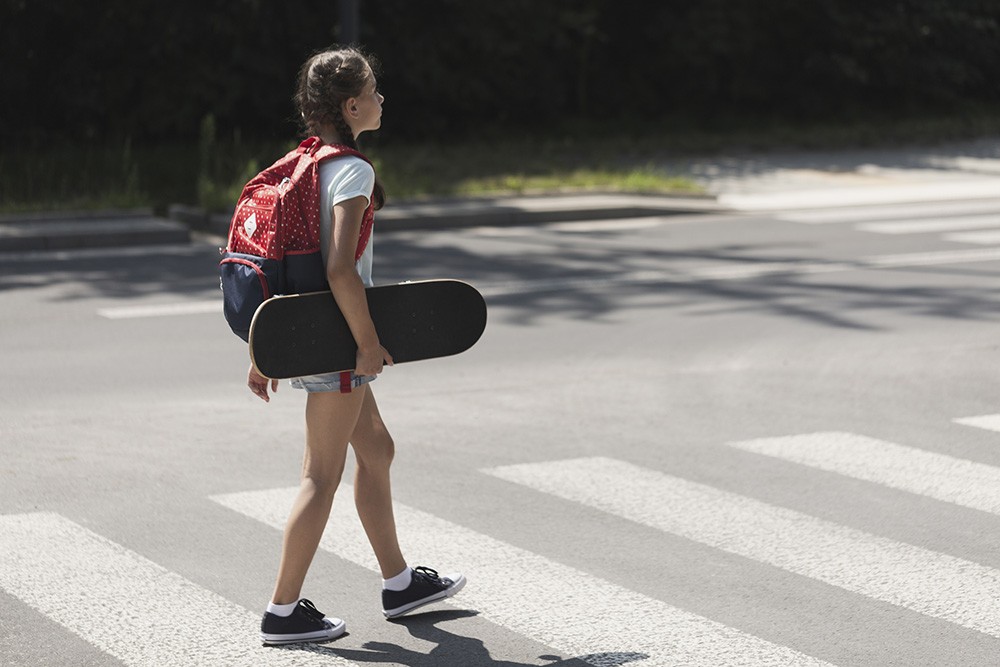
School zones are among the most welcoming places for children, but they also have become one of the dangerous places for them to walk or ride their bikes.
“There’s a lot of activity that happens between arrival time and dismissal time that can be distracting and that’s the piece that can make it risky for young pedestrians,” said Nancy Pullen-Seufert, director of the National Center for Safe Routes to School.
Some 78% of drivers speed through school zones and 82% illegally pass school buses, according to one survey conducted by the National Association of State Directors of Pupil Transportation Services. After-school hours from 3 to 4 p.m. are the highest risk for school-age pedestrians and with the highest number of vehicle accidents involving children occurring during this time frame.
“This is a widespread worry by families and school staff. We all want to live in communities where people feel safe having their children go to school and come home again safely.”
Pullen-Seufert has held leadership roles in school travel safety since 2006, contributing over 19 years of expertise and experience toward creating safe walking and biking environments for children. Her work includes quick-build solutions like pop-up bike lanes, traffic calming measures and temporary street modifications designed to protect children on their way to school.
Pullent-Seufert provides safety driving tips for daily commuters and parents dropping off their kids in school zones.
Obey the Speed Limit
Driving faster also means longer stopping distances. Most school zones have speed limits of 20 mph or less.
And at 20 mph, it takes an average vehicle 69 feet to come to a total stop and nearly twice the distance at 30 mph.
According to the National Highway Traffic Safety Administration, 5% of pedestrians hit by a vehicle at 20 mph suffer a fatality. The number increases to 45% if the vehicle is going 30 mph and 80% for those struck by a vehicle traveling at 40 mph.
“The faster you’re going, the more likely you are to injure a pedestrian and to injure them seriously,” Pullen-Seufert said.
Use Designated Drop-Offs
Use the school’s designated drop-off zone instead of letting children cross the street.
“Oftentimes parents get very tempted to drop their child off across the street from the school and tell their child to just run across the street. Any time any pedestrian of any age is crossing the road, they are at a greater risk,” Pullen-Seufert said.
Children are less visible to drivers especially during early morning rush hours and may misjudge the speed or distance of oncoming cars. Pullen-Seufert advises parents to use the drop-off area where children exit directly onto a sidewalk or a safe pathway away from moving traffic.
Stop Signs and Crosswalks
Motorists must stop at stop signs before they reach a crosswalk area. Do not block a crosswalk as it forces kids to walk around your vehicle which puts them at risk.
Pullen-Seufert encourages drivers to always be patient and wait for crossing guards to clear the intersection before moving.
"There are often one or two kids who fall behind and then dash across the crosswalk to rejoin classmates," Seufert said.
This sudden movement can catch drivers off guard, especially if they are already distracted. Always stay alert, keeping an eye on the crosswalk and the area directly ahead.
Stay Off Mobile Devices
Talking or texting on your mobile phone reduces a driver’s reaction time. Leave your phone in a place where you aren’t going to be distracted.
“Make eye contact with school-age pedestrians that want to cross the road,” Pullen-Seufert said.
According to her, if the children have not made eye contact, motorists should assume that they have not been seen and drive cautiously.
Don’t Pass School Buses
Look for school buses with red lights flashing and a stop arm extended. That’s a signal children are getting on or off the bus and may be crossing the street.
Even if you’re running late, exercise patience and be willing to wait a few minutes until the road is clear.
Children are physically less visible than adults and can drop something, turn back unexpectedly or cross the road more slowly than anticipated. Stopping and waiting until bus signals are turned off ensures the children have reached sidewalk safety or a designated drop-off area.
Nancy Pullen-Seufert offers the following safe driving tips in school zones:
- Slow down when entering a school zone. Reduced speeds give you more time to react when children step unexpectedly into the roadway.
- Always obey crossing guards and school safety patrols. Wait until they signal it’s safe before moving forward even if the coast looks clear.
- Do not block a crosswalk. Stopping on a crosswalk forces children to walk around your vehicle putting them directly in harm’s way.
- Be on the lookout for students arriving late to school. They may run across the road to avoid being late for class.
- Avoid distractions completely. Put away your phone so your undivided attention stays on the road, pathways and crosswalks.
- Be extra cautious around school buses. Stop when their red lights are flashing and wait until the signals are off before moving.
According to Pullen-Seufert, creating safe school zones is not just up to schools or parents–it’s a shared responsibility with every driver on the road.
“Every driver has a role in protecting students. Safe school travel depends on all of us making careful, and responsible choices behind the wheel,” Pullen-Seufert said.
Copyright © 2024 by Sensible Driver. All rights reserved.